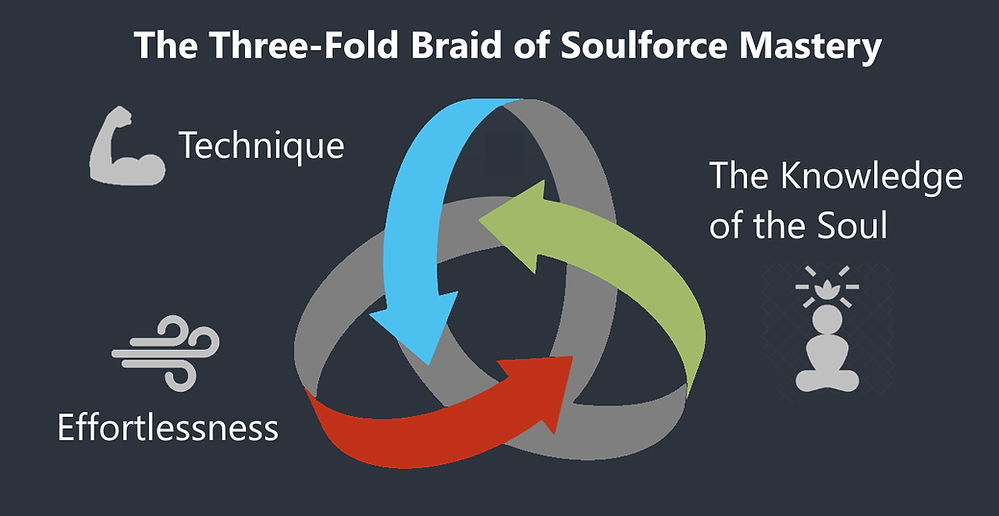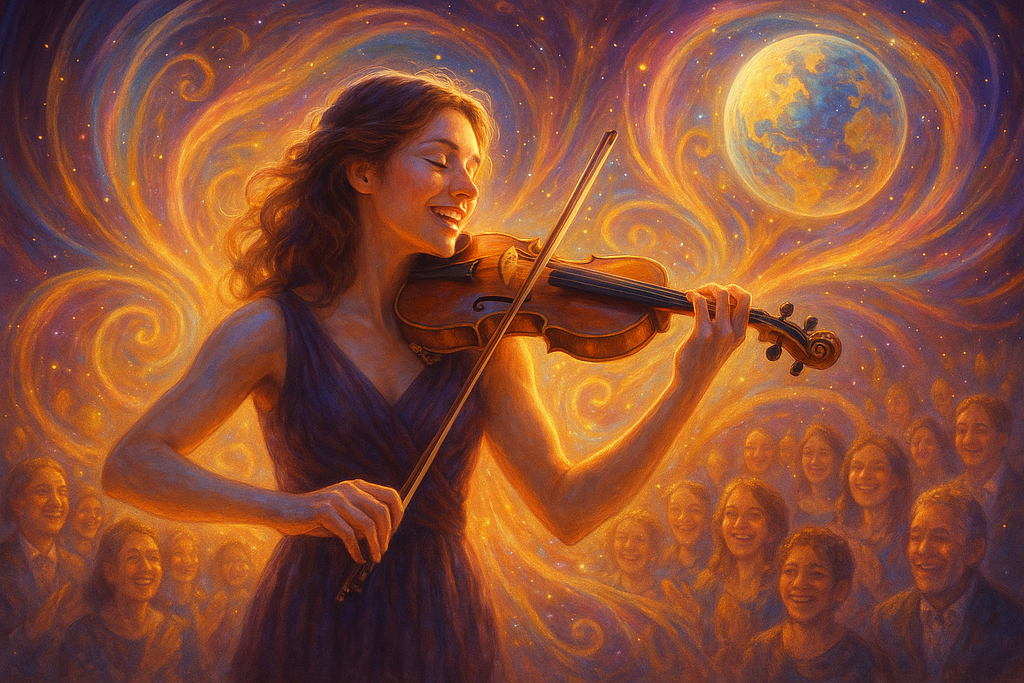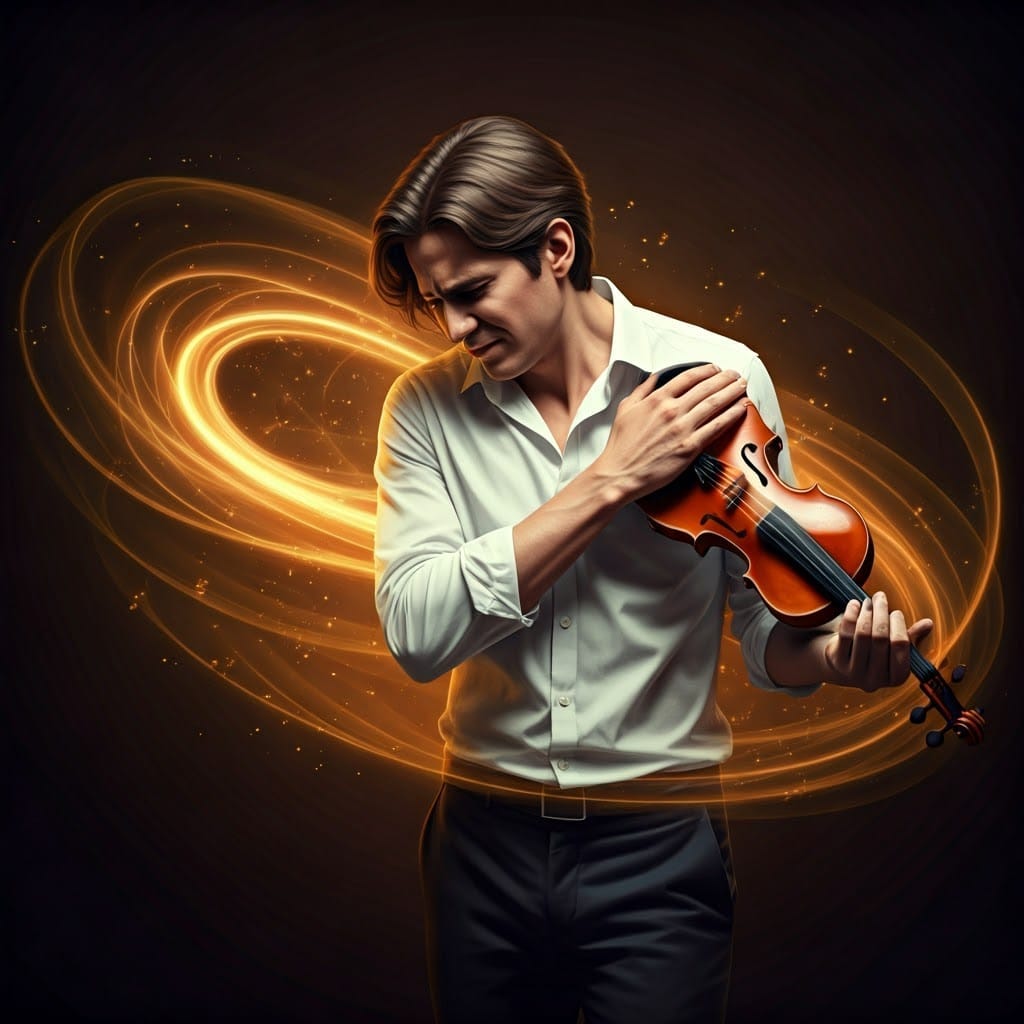Is virtuosic technique sufficient for true mastery of your art form? Well, it’s certainly necessary, but it’s not sufficient by itself. Any approach to artistic development that focuses too much on technique will just end up feeling effortful and unsatisfying. That’s because it’s missing two thirds of the whole picture!
The missing pieces to true artistic mastery are *effortlessness* and *the Knowledge of the Soul*. After all, can you really say you’ve mastered something if it isn’t effortless? And without connection to your soul, what would you even be trying to express with all that technique?
True artistic mastery balances all three strands of what I call the “Three-Fold Braid of Soulforce Mastery.” This includes technique, effortlessness, and the Knowledge of the Soul.
This video features an excerpt from Chapter 3 “The Soulforce Arts Approach” from my upcoming book. Read the full excerpt from this video below.
Be among the first to know about my upcoming book “Soulforce Arts: The Vital Role of Musicians & Other Artists in a World That’s Lost Its Mind” by signing up for my mailing list at JosephArnold.com.
Joseph Arnold Violinist, Alexander Technique Teacher, Director of the Soulforce Arts Institute
The Three-Fold Braid of Soulforce Mastery
“If you’re an open channel when you’re onstage, if you’re just a vessel, things are going to come out that are stored away deep in your DNA.”
– Leslie Odom, Jr.
The Soulforce Arts Approach takes for granted that your greatest expressive power, your Soulforce, is in some sense already fully formed inside you. Its essence is not something external to you, something you need to reach for in order to achieve. It is inherent to who you are, just waiting to be given form and released.
This idea sheds new light on what it means to master your art form, and stands in contrast to conventional approaches to mastery in the arts. A hidden assumption within these approaches is that the path to mastery is a combination of pure luck (you were either born with a special creative talent or you weren’t), sufficient hard work (as in Malcom Gladwell’s famous 10,000-hour rule), and technique (the more virtuosic the better). Obviously, luck, hard work, and technique all have their roles to play in the path to mastery. But they are not the whole story. Relying on luck is deeply disempowering; after all, what do you do if you’re not one of the lucky few? It’s also possible to work hard and exert great effort, but without real gain or creative fulfillment. And it’s possible to have the most virtuosic technique without any connection to Soul.
The Soulforce Arts Approach recognizes these shortcomings and instead defines mastery in terms of what will allow for your greatest connection with Soulforce. Soulforce Mastery comprises an interconnected braid of three strands: technique, effortlessness, and the Knowledge of the Soul. Soulforce Mastery happens when you’re in connection with your Knowledge of the Soul, when you have sufficient technique to give form to whatever is inside your Soul, and when you can move your body freely enough to become an open channel for whatever wants to come through you. You know you have reached Soulforce Mastery when you feel like you’ve become a vessel for your art.
Soulforce Mastery comprises an interconnected braid of three strands: technique, effortlessness, and the Knowledge of the Soul.
Each of the three strands of Soulforce Mastery are necessary, and none is sufficient by itself. Each one depends on the others for its fulfillment, and when one is lacking, the others will fail to meet their full potential. Soulforce Mastery suggests that true artistic mastery, wherein you create art or music that transforms yourself and the world around you, is only possible when you have developed all three strands to a high degree.

Technique. The first strand, technique, involves all the things that trained artists already know how to do well: taking lessons, developing the mechanics of your art, learning repertoire, copying the masters, learning how to collaborate, learning how to create in various contexts and formats, gaining experience as a professional artist, learning theory, and more. Technique is necessary for giving form to your creative ideas. When developed alongside effortlessness and the Knowledge of the Soul, having virtuosic technique is wonderful because it allows you the quickest, richest, and most effortless translation of your ideas into a more concrete form. And without a sufficient level of technique, you will likely be frustrated by your inability to express what’s inside you. This is a gap that no degree of effortlessness or Knowledge of the Soul can bridge on their own.
But the development of technique comes with a word of caution. Among the three strands of Soulforce Mastery, technique is the most easily understood and co-opted by the Story of Separation. One result is that, in our society, technique tends to be the primary focus in art and music education, even to the point that emotional expression itself is often taught as a technique to be acquired and reproduced at will. Without the Knowledge of the Soul, the development of technique leads to an empty, stale, Soulless virtuosity, where you have the how, but not the why. And without effortlessness, the development of technique leads to the build up of muscular tension, physical discomfort, and even injuries.
Effortlessness. The development of effortless bodily movements is essential for all artists. On one level, effortlessness skills are necessary to relieve the tension that is the underlying cause of physical discomfort, as well as injuries like back pain and tendinitis. Learning such skills will help you feel more at ease, comfortable, and confident during your creative processes. Your effortlessness is also a big part of what your audiences want to experience from you and your art. Many people seek out artistic experiences in order to feel refreshed and relaxed, and the best way to offer that to them is for you to be at ease in yourself, even during the most challenging artistic moments.
Effortlessness complements the development of both technique and the Knowledge of the Soul. For example, effortlessness is essential for emotional expression in the arts; it is how you open a channel within so that your Knowledge of the Soul can shine through. Effortlessness is also the key for making swift progress in developing technique; oftentimes, when a technique feels awkward or just isn’t working, it’s because you’re using too much effort. And while the conventional approach–practicing more–can, with time, bring a degree of ease to the material at hand, it also ignores a vital truth: how you practice becomes how you perform. In other words, practicing with tension creates performances with tension. But having a toolbox of effortlessness skills will prevent you from ever-more-deeply ingraining excess effort into your creative practices. And when you first experience how a single moment of effortlessness can propel you towards greater technical achievement than might otherwise have occurred through six months of diligent practice, you will naturally be motivated to infuse your entire approach to learning technique with a healthy dose of effortlessness. Indeed, many highly-trained musicians and artists don’t really need more technical training; they have done enough hard work and can discover much greater gains through letting go.
Effortlessness is essential even for artists who don’t think of their body as an important part of the creative act. Many writers, photographers, designers, and others often don’t realize the profound role their body actually plays in their creative process. It helps to consider that having tight muscles is not just a physical issue–it actually affects every part of your being, including your imagination and emotions. These essential creative faculties have their root in the body, and any muscular tension you hold dampens your connection with them.
Unfortunately, effortlessness is much neglected in conventional arts and music education beyond the admonition to “just relax.” But unless you have actual training in effortlessness, this advice is worse than useless; when you don’t know how to relax in moments of creative challenge, the attempt to do so nonetheless can become just another thing to get stressed out about. Thus, effortlessness should be an integral component of your path to artistic mastery. After all, can you really say you’ve mastered something if it isn’t effortless?
The Knowledge of the Soul. The Knowledge of the Soul is whatever that is inside you that wants to be expressed. It is the core to who and what you are, the essential energy that you radiate without even trying. It is the source of authentic emotional expression and creative insights.
The Knowledge of the Soul has a somewhat paradoxical nature in that it has both personal and impersonal aspects. On the one hand, it is uniquely yours in that it is a reflection of the sum total of your life’s experiences, artistic and otherwise. And on the other hand, it may hold things that you, as your ego, may find surprising, or which may connect you to a feeling of something bigger than your individual self.
Ultimately, your Knowledge of the Soul, given form by excellent technique, and freely expressed through your effortlessness, is your greatest gift to the world around you. It is the core of your system update, whose transformative potential increases in direct proportion to your degree of connection and development of your Knowledge of the Soul. It is the why for your art, without which the development of effortlessness and technique have no real purpose.
While the importance of the Knowledge of the Soul may be intuitive and obvious to many, like effortlessness, it doesn’t really get the attention it deserves in many art and music education settings. This may be due to the simple fact that it’s easier to talk about a technique than an ineffable feeling. But your Knowledge of the Soul can be developed and deepened, and doing so actually improves your technique and effortlessness. The process of deepening the Knowledge of the Soul is one of increasing self-awareness, and with such awareness comes a confidence and ease that will be reflected in your physical movements. And furthermore, when you know yourself better, you’ll know what you want to give form to. This will free you from trying to improve your technique through tedious exercises because the development of your technique will be tied to something you actually care about, and so become fun and fulfilling.
Thus, instead of merely maximizing virtuosic technique, when you develop all three strands of Soulforce Mastery together, you give yourself what you need in order to enjoy a balanced and fulfilling artistic practice. And this holds true whether you’re a seasoned professional or a hobbyist with no intentions of fully mastering an art form. No matter your ambitions, you will more quickly and completely reach your full potential as an artist with the Three-Fold Braid of Soulforce Mastery.



